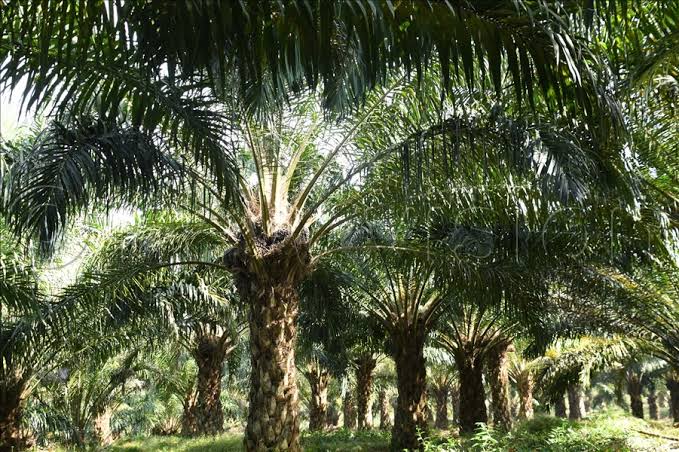Like virtually every project or programme in Uganda, oil palm (Elaeis guineensis Jacq) growing started in Uganda because the President Tibuhaburwa Museveni committed a lot his political time and energy in it. Like all other projects or programmes, what was a solidly politically advanced Vegetable Oil Development Project by President Tibuhaburwa Museveni soon became a Uganda Government Project.
It all started in the early 2000s with the involvement of the World Bank, which had become central to every initiative by the President to commercialise the economy under the aegis of economic liberalisation and privatisation. The first commercial planting of oil palm occurred on Bugala Island in Kalangala District in Lake Victoria in 2005.
The planting was preceded by widespread felling of forest trees to replace them with oil palm plantation. The project was falsely sold as forest propagation, to convince the affected public that there was no loss of forest, yet oil palm is a type of grass that casts itself as if it is a tree. What was being planted was not a forest but a plantation of oil palm. Economically the project was sold as the gateway to saving foreign exchange that was being lost to importation of crude vegetable palm oil.
Naku John (2022), the Principal Private Secretary of the Kyabazinga of Busoga, then a final year student at Makerere University, wrote a long article in the New Vision of 8 November 2022 by the Title “Why Busoga Should Embrace Oil Palm Growing”. Since he was the principal Private Secretary of the Kyabazinga, this could be perceived as the thinking of Kyabazinga William Wilberforce Kadhumbula Gabula Nadiope IV. The intervention of the Kyabazinga in the oil palm growing in Busoga reminds me of the intervention of late Kyabazinga Henry Wako Muloki in the Bujagali Dam process when he literally endorsed the destruction, by the Central Government, of Bujagali Falls for a hydropower facility although environmentalists, ecologists, culturalists and traditional spiritual leaders led by the Bujagali, opposed the project.
Two years after Naku’s article THE INDEPENDENT (2024) reported that oil palm growing stated in Mayuge District after 13 yeas of waiting. One year after Naka’s article MUWADO published my article titled “The Curse of Palm Tree Plantation in Uganda. I made it clear that the NRM government, the International Foundation for Agricultural Development (IFAD) and the World Bank were working together by 2002 to see that the whole of Northern Uganda and three quarters of Eastern Uganda are turned into extensive plantations of the false tree, oil palm. I should have included that they wanted half of Buganda to be under oil palm growing. Only Western Uganda would be spared from oil palm growing. I stated that “Indeed, that year IFAD produced a report in which there was a map of Uganda showing that all the islands of Lake Victoria, the whole of Northern Uganda and three-quarters of Eastern Uganda would be converted into Oil Palm territory”. To this add half of Buganda.
I observed that Busoga seemed to have been prepared well for embracing oil palm growing. Most of the subregion’s land has been converted to sugarcane growing. People have cut most of their trees to establish sugarcane plantations. They no longer want to grow coffee. There is every likelihood that prices of sugarcane will fall meteorically, leading to further poverty. The subregion is now the second poorest in Uganda, although in the 1960s it was rich enough to compete with Buganda. I predicted that when the sugarcane growing collapses and leaves only the historical sugarcane farmer, Madhivan, in business, the government is likely to swing in and convince former sugarcane farmers to turn to oil palm farming. Bidco, the oil firm with nearly 10,000 hectares of oil palm plantations in Kalangala, already has its headquarters in Busoga. It is likely that Bidco strategised to locate its headquarters in Busoga, with the full knowledge that the region would fall to oil palm growing sooner than later.
Because palm fruits can be harvested throughout the year (compared to one or two seasonal harvests of other crops) and have high yields, palm farming has become a viable alternative for the residents (Taylor, 2024), the temptation to make money quickly to conquer poverty is the main drive for people embracing the growing of oil palm.
There is reliable information that my own District, which because of poverty, had wholeheartedly fallen prey to sugarcane growing, has now wholeheartedly fallen prey to oil palm growing. On Busoga One fm yesterday 6th March 2025, I hear the Chairman of Luuka District Council, Simon Wakaze thanking an oil farm, most likely BIDCO, for constructing roads in association with oil palm growing. The Daily Monitor of 15 January 2025 reported that the government had failed to 100,000 ha oil palm target, having put on 55,830 ha of land under the crop. It is likely that oil palm growing will be speeded up in poverty-stricken Busoga, now frustrated by meteorically falling sugarcane prices and faced with the real possibility that people will migrate to oil palm growing. Currently Uganda produces between 83,000 and 97,000 metric tones of cooking oil annually but consumes about 200,000 metric tonnes of cooking oil annually (Kyanjo and Ssenkabirwa, 2025). Government’s target was 410,00 metric tonnes of cooking oil products by 2025.
My concern as a biological conservationist and environmentalist is that the oil palm growing is very much responsible for environmental and ecological degradation in Uganda in general and Busoga in particular. By extension the current heat wave we have experienced in Busoga in particula and Uganda in general has a lot to do with oil palm growing. However, instead of apportioning much of the blame to oil palm growing, most of the blame is being directed at poor and needy Ugandans and/ or Basoga trying to meet their energy needs while the few remaining trees are being cut to give way to oil palm. Besides, the herbicides used to protect the oil palm from pests, as the experience of Kalangala showed, find themselves in the freshwaters, where they can harm wildlife and humans. It is important that serious scientific research is done to establish the negative environmental and ecological impacts in the short, medium and long-term.
For God and My Family
Further Reading
Naku, John (2022). Why Busoga Should Embrace Oil Palm Growing IN: New Vision, November 8 2022. https://www.newvision.co.ug/category/blogs/why-busoga-should-embrace-oil-palm-growing-NV_147000 Visited on 7 March 2025 at 10:53 am EAT.
Otuba Moses Amugoli, Fred Bwayo Masika, Alex Asiimwe and Gabriel Ddamulira (2022). Challenges and Opportunities of Oil Palm Production in Uganda. Chapter 4. IN:
Viduranga Y. Waisundara (Academic Editor). Palm Oil – Current Status and Updates. Amazon. https://www.intechopen.com/chapters/84209 Visited at 11:58 am EAT.
Oweyegha-Afunaduula (2023). The Curse of Palm Tree Growing in Uganda. MUWADO, December 7, 2023. https://muwado.com/the-curse-of-palm-tree-plantation-in-uganda/?v=2a0617accf8b Visited on 7 March 2025 at 11:35 am EAT
Polycarp Musimami Mwima, Michael Opige Odull, Richard Ssemmanda (?). Analysis of oil palm projects in Uganda (2002-2018) – impacts and implications for future development. Ecological Trends Alliance, http://www.ecotrendsalliance.org/assets/files/Article-Musimami-Opige-Ssemmanda.pdf Visited on 7 March 2025 at 11:12 am EAT.
Paul Taylor (2024). Ugandan Farmers Tap Palm Oil and Cutting-Edge Tech To Transform Lives. Forbes, https://www.forbes.com/sites/sap/2024/03/20/ugandan-farmers-tap-palm-oil-and-cutting-edge-tech-to-transform-lives/ Visited on 7 March 2025 at 11:18am EAT.
Richard Kyanjo and AL-MAHDI SSENKABIRWA (2025). Govt fails to meet 100,000 hectares oil palm target. Daily Monitor, January 15, 2025. https://www.monitor.co.ug/uganda/news/national/govt-fails-to-meet-100-000-hectares-oil-palm-target-4890414 Visited on 7 March 2025 at 12:02 am EAT
The Independent (2024). Oil Palm growing finally starts in Busoga after 13-year wait. The Independent, April 15, 2024. https://www.independent.co.ug/oil-palm-growing-finally-starts-in-busoga-after-13-year-wait/ Visited on 7 March 2025 at 11:25.
This post was created with our nice and easy submission form. Create your post!





